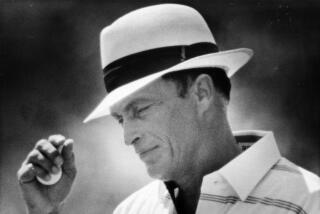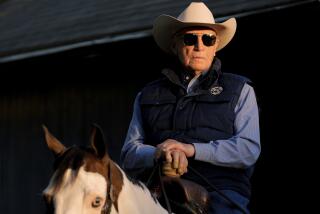What a Difference Two Decades Make
- Share via
He shot a 30 on the back nine on Sunday. He hit a one-iron to the green at the 15th hole and made an eagle. He came from a tie for ninth and four shots back on the last day, closed with a 65, and won by one stroke.
Those are the facts of a round that has lost none of its power to amaze in the two decades since it was played. Because of that round, on Sunday, April 13, 1986, it might have been the greatest Masters ever, when Jack Nicklaus won for a record sixth time at Augusta National and became the tournament’s oldest champion at 46.
“It’s 20 years since that happened,” Nicklaus said this week. “Seems like yesterday.”
What that victory at the Masters represents extends far beyond the scope of a single tournament or even a legendary career.
Nicklaus didn’t invent the record book, he just filled it up.
At the top of his achievements are the 18 major championship titles he owns, a total recognized for its heft and its difficulty, and also for providing a target for Tiger Woods.
We’ve been keeping score, so most know that Woods trails Nicklaus in majors, 18-10, in victories, 73-48, and in Masters titles, 6-4.
When Nicklaus won the 1986 Masters, Woods was 10.
The 1986 Masters was not only his final victory at Augusta National, Nicklaus never won another PGA Tour event.
It was the end of an era, only nobody knew it yet. It’s possible to view Nicklaus’ monumental Masters of 20 years ago as a unique jumping-off place for professional golf, a final,
startling, heart-warming salute to one generation and the start of something radically new.
Nicklaus won the 1986 Masters and nothing has been the same since. They’re no longer playing the same game.
His winning check was $144,000. Woods made $1.26 million for winning the Masters last year.
In 1986, the total prize money available in PGA Tour events was $25.4 million, about $545,000 each tournament. This year, the pros are playing for a pool of $256.8 million, an average of about $5.4 million a tournament.
Greg Norman led the money list in 1986 with $653,296. That would have put him 121st on the money list in 2005, when 78 players made more than $1 million.
And Nicklaus’ Masters victory in 1986 clearly represents the end of an era in more ways than money.
The two most important pieces of equipment in golf were going to take on a drastic new look.
It wasn’t until 1991 that Callaway Golf revolutionized drivers with the large-headed Big Bertha, shoving into the back of the closet the flat-faced, unforgiving block of persimmon wood on a steel shaft.
And it was in 2003 when Titleist brought out its Pro V1 ball. A three-piece ball instead of a wound ball, and with a thinner cover, the Pro V1 was immediately hailed for its greater control, better feel, improved trajectory and longer flight.
The combination of driver and ball has altered golf’s landscape, perhaps forever.
In 1986, Nicklaus averaged 266.4 yards off the tee. A 22-year-old Davis Love III led the driving statistics, averaging 285.7 yards and the PGA Tour average drive was 261.6 yards. The 190th and last-ranked player in driving distance this year is Brad Faxon at 260.7 yards. Love is ranked 27th in driving, averaging 299.3 yards, but 23 players are averaging more than 300 yards.
Woods, by the way, is eighth, with a 304.8-yard average. Bubba Watson is hitting it farther than anyone, averaging 320.9 yards, and the average PGA Tour pro drives the ball 289 yards -- about 27 yards farther than the average pro in 1986. And Watson’s lead over what Love averaged in 1986 is more than 38 yards.
Don’t think these kind of numbers have been overlooked. Just check the numbers at Augusta National. In 1986 when Nicklaus won, it was listed on the scorecard he kept at 6,905 yards. In a couple of weeks, they’re going to play a course that’s 7,445 yards and has been lengthened for the third time in seven years.
At Whistling Straits for the 2004 PGA Championship, the layout measured 7,514 yards, the longest course ever played in a major.
Four years after Nicklaus’ victory at the Masters, the U.S. Open returned to Medinah for the first time since 1975 and Hale Irwin won it, playing a course that measured 7,195 yards. It’s going to play at 7,561 yards for the PGA Championship in August and the 14th hole is 605 yards. That shouldn’t surprise anyone, because the 17th hole at Baltusrol for the PGA Championship last year topped out at 650 yards.
The debate will go on about whether the proper way to toughen courses because of better players and better equipment is to simply make them longer, but that’s not the point here.
The fact is that they are longer because the game is very different than it was, not so long ago, about the time of Nicklaus’ crowning achievement in 1986, when they were playing a different game.
More to Read
Go beyond the scoreboard
Get the latest on L.A.'s teams in the daily Sports Report newsletter.
You may occasionally receive promotional content from the Los Angeles Times.










